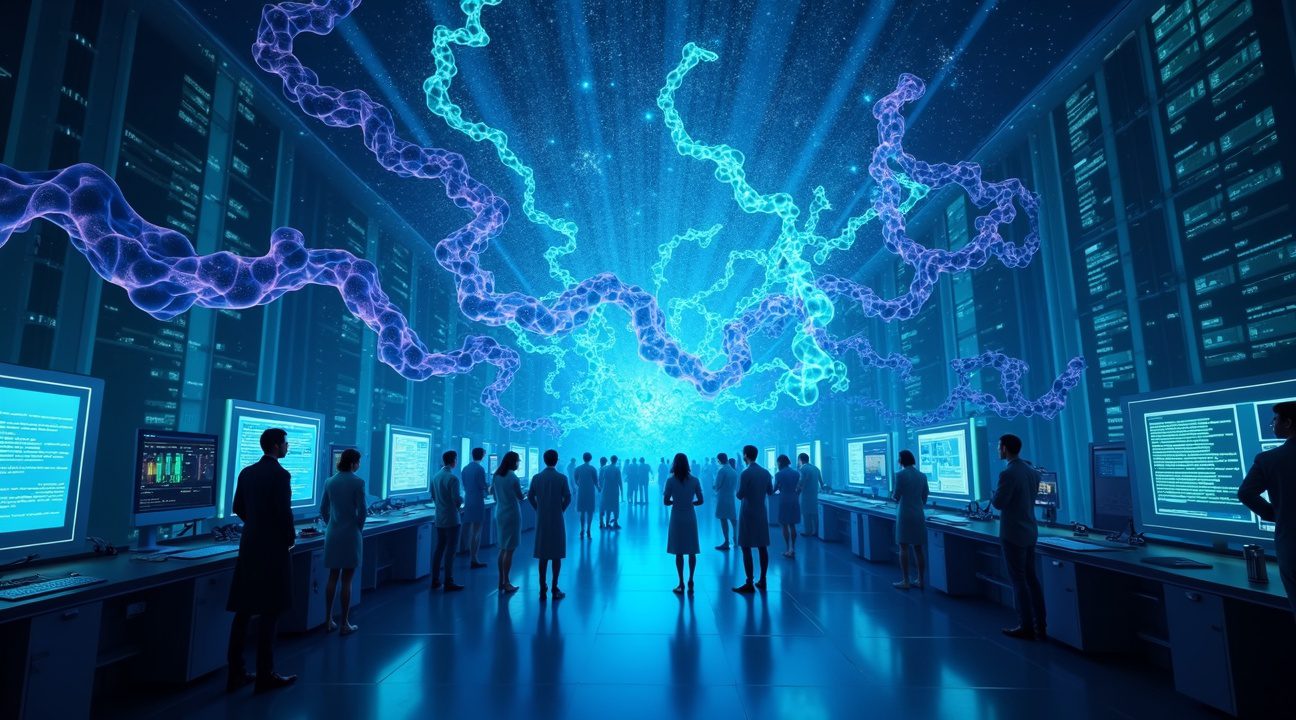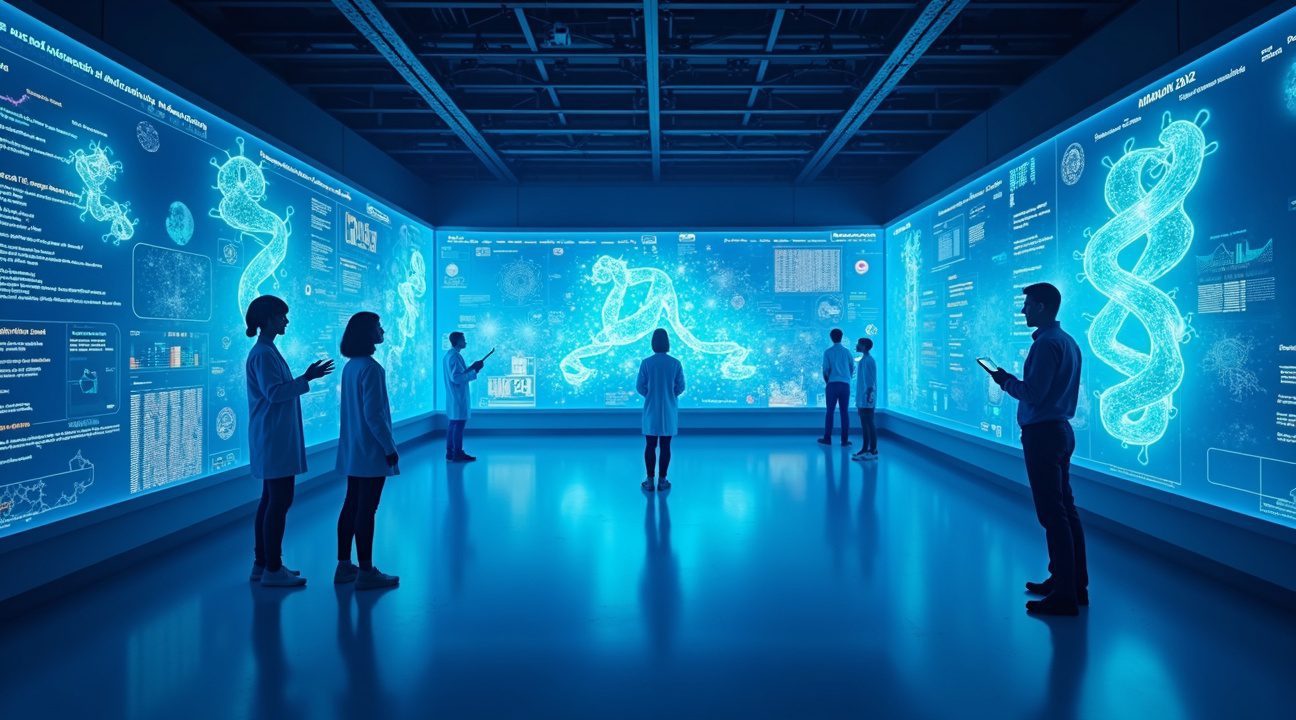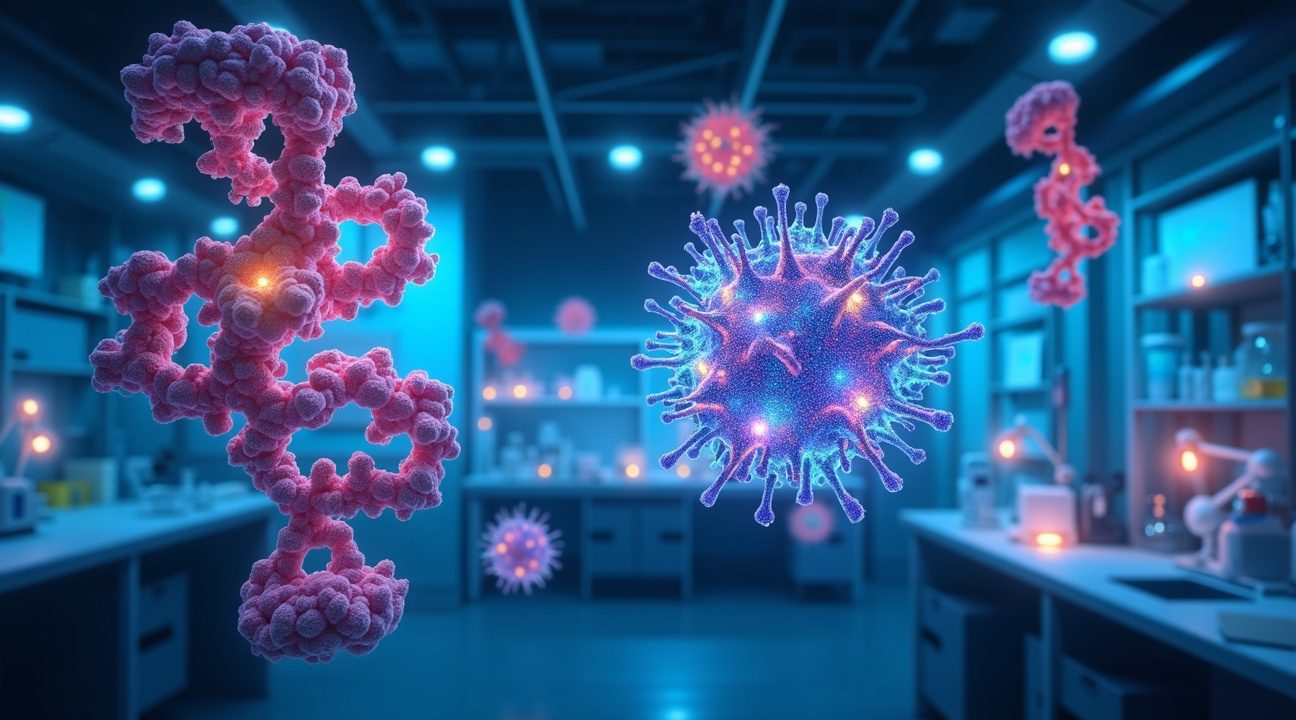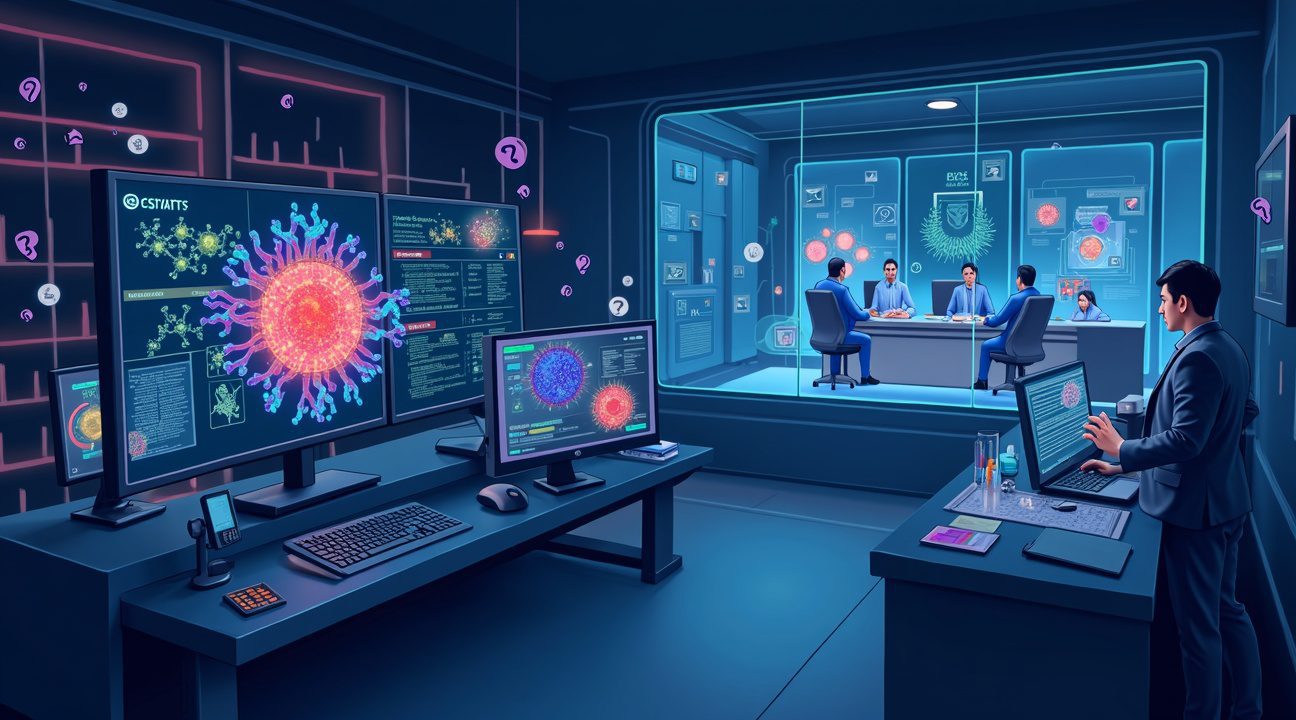Google’s DeepMind has transformed biological science by using its AlphaFold AI system to discover over 300 million new protein structures hidden within nature’s genetic code, expanding the known protein universe by more than 1,000-fold compared to traditional experimental methods.
Key Takeaways
- AlphaFold AI predicted 200–300 million protein structures, dramatically increasing the known number of proteins from fewer than 200,000 determined experimentally over decades to hundreds of millions in a short time.
- This achievement earned researchers the 2024 Nobel Prize in Chemistry and led to the creation of the largest open biological database, democratizing access to protein structures for scientific institutions around the world.
- Pharmaceutical giants such as Pfizer, Eli Lilly, and Novartis have adopted AI-driven protein discovery into their core research and development pipelines. Industry forecasts project as many as 50 new therapies and approximately $50 billion in commercial potential over the next decade.
- AI-powered biotechnology could reduce global emissions by 5% while unlocking up to $1 trillion in value across industries like food production, agriculture, chemicals, and fuels.
- Despite these advancements, experimental validation remains a challenge. Questions related to intellectual property and patent rights for AI-generated molecules are still unresolved, creating significant obstacles for commercial implementation.
For those interested in exploring this open database, DeepMind has made the AlphaFold protein structure database freely available, marking a major step in democratizing access to biological data and accelerating scientific discovery worldwide.
AlphaFold AI Expands Known Protein Universe by 1,000-Fold
Google’s DeepMind has achieved a scientific breakthrough that fundamentally transformed our understanding of proteins through its AlphaFold AI system. This remarkable technology predicted over 200 million to 300 million new protein structures hidden within biological code, representing one of the most significant advances in computational biology.
The scale of this achievement becomes clear when comparing it to traditional methods. Scientists had experimentally determined fewer than 200,000 protein structures across decades of research before AlphaFold’s introduction. This means the AI system increased known protein structures by more than 1,000-fold, essentially expanding our view of the protein universe exponentially.
Revolutionary Database Creation
The AlphaFold Protein Structure Database now stands as one of the largest open biological resources ever created. I find it fascinating that this database currently hosts over 200 million predicted protein structures, with recent advances pushing closer to the 300 million mark. Scientists worldwide can access this treasure trove of structural information freely, accelerating research across multiple disciplines.
This database represents more than just numbers. Each predicted structure provides crucial insights into how proteins fold and function, information that previously required expensive and time-consuming laboratory experiments. Research teams can now explore protein structures for organisms ranging from bacteria to plants to humans, opening new avenues for drug discovery and biological understanding.
The implications extend far beyond academic research. Pharmaceutical companies leverage these predictions to identify potential drug targets more efficiently. Agricultural scientists examine plant proteins to develop more resilient crops. Environmental researchers study proteins from extremophile organisms that might offer solutions for biotechnology applications.
DeepMind’s approach combines advanced AI techniques with decades of accumulated biological knowledge. The system analyzes amino acid sequences and predicts how they fold into three-dimensional structures, solving what scientists call the “protein folding problem.” This challenge had puzzled researchers for over 50 years before AlphaFold demonstrated reliable solutions.
The open-access nature of the database democratizes protein research. Small research institutions and developing countries can now access the same structural information as major pharmaceutical companies. This leveling of the playing field has accelerated scientific discovery and collaboration across borders.
Scientists continue expanding the database as new genomic sequences become available. Each addition brings us closer to understanding the complete catalog of protein structures that exist in nature, potentially reaching that 300 million milestone as genomic sequencing projects identify more organisms and their unique proteins.

Deep Neural Networks Revolutionize Protein Structure Prediction
AlphaFold represents a fundamental shift in how scientists approach protein structure prediction. This groundbreaking system employs deep neural networks trained on massive genetic datasets to predict the 3D atomic structure of proteins directly from their amino acid sequences. The AI eliminates much of the guesswork that has plagued researchers for decades.
Traditional physics-based simulations demanded enormous computational resources and time to model how proteins fold into their functional shapes. AlphaFold’s approach proves far more efficient, requiring significantly less computational power while delivering unprecedented accuracy. The system processes amino acid sequences and generates precise structural predictions in a fraction of the time needed by conventional methods.
The Technical Foundation Behind the Breakthrough
The prediction process centers on multiple-sequence alignment and the creation of pairwise amino acid spatial relationships. I find this approach particularly clever because it leverages evolutionary patterns hidden within genetic sequences. The system analyzes how similar proteins have evolved across different species, identifying conserved regions that provide crucial structural clues.
Large-scale GPU clusters power this computational marvel, with thousands of GPU-years of compute required for training and database generation. The transformer model architecture, similar to what drives modern artificial intelligence systems, processes these complex relationships efficiently. Each protein prediction involves intricate calculations that map amino acid sequences into three-dimensional coordinates.
The neural networks learn from millions of known protein structures, identifying patterns that connect sequence information to folded shapes. This training enables AlphaFold to make accurate predictions for proteins never before seen in laboratory settings. The AI recognizes subtle sequence motifs and structural constraints that human researchers might overlook.
AlphaFold’s remarkable success earned its researchers the 2024 Nobel Prize in Chemistry, validating the transformative impact of AI on biological sciences. The recognition highlights how machine learning approaches can solve problems that have challenged scientists for generations. This achievement mirrors other recent AI breakthroughs, such as Google’s advances in language models, demonstrating AI’s expanding influence across scientific disciplines.
The system’s ability to predict protein structures at atomic resolution opens new possibilities for drug discovery, enzyme design, and understanding disease mechanisms. Researchers can now explore the vast universe of possible proteins without waiting years for experimental structure determination. This computational approach accelerates scientific discovery while reducing costs associated with traditional experimental methods.

AI-Generated Proteins Transform Drug Discovery and Generate Billions in Opportunities
The pharmaceutical industry is experiencing a fundamental shift as AI-generated protein structures reshape how companies develop new medications. I’ve observed how this technology has moved from experimental curiosity to essential business infrastructure within just a few years.
Major Pharmaceutical Investment and Integration
Leading pharmaceutical giants have quickly recognized the potential of AI protein discovery. Pfizer, Eli Lilly, Novartis, and Merck have all integrated these AI advancements into their core drug discovery pipelines, treating them as strategic necessities rather than experimental tools. These companies are leveraging AlphaFold and related AI systems to model complex molecular interactions with unprecedented accuracy.
The applications extend far beyond basic research. AI systems now enable scientists to design new binders for challenging disease targets, including:
- Various forms of cancer
- Autoimmune diseases
- Viral infections
This capability represents a significant leap forward from traditional methods that often relied on trial-and-error approaches spanning years or even decades.
Accelerated Timelines and Economic Impact
The speed improvements are remarkable. In one-third of cases, AI-accelerated predictions have cut years off project timelines compared to traditional experimental structure determination methods. This acceleration translates directly into reduced costs and faster patient access to life-saving treatments.
Industry analysts project that AI could enable 50 novel new therapies over the next decade, creating a $50 billion pharmaceutical opportunity. These projections reflect not just the technology’s current capabilities but its potential to unlock previously “undruggable” targets that have frustrated researchers for generations.
The transformation mirrors broader trends in artificial intelligence development, where computational breakthroughs are creating entirely new categories of business opportunities. Drug companies that once spent millions on protein crystallization and years on structural analysis can now access detailed protein models within hours.
This shift has profound implications for biotechnology and molecular biology research. Smaller biotech companies can now compete with pharmaceutical giants by accessing the same high-quality protein structures that were previously available only to organizations with massive research budgets. The democratization of protein structure prediction is leveling the playing field and accelerating innovation across the entire industry.
Companies are also discovering that AI protein models excel at predicting how different molecules will interact, enabling more precise drug design from the earliest stages of development. This precision reduces the number of failed experiments and increases the likelihood of successful clinical trials.
Competing AI Models Push Beyond Natural Protein Boundaries
Google’s breakthrough in discovering 300 million new proteins represents just one chapter in the rapidly expanding story of artificial intelligence transforming molecular biology. I find it fascinating how multiple research teams and companies are simultaneously pushing the boundaries of what’s possible with protein prediction and design using increasingly sophisticated AI approaches.
Advanced AI Models Revolutionizing Protein Science
Several cutting-edge AI models are making remarkable strides in protein research, each offering unique capabilities that extend far beyond traditional structure prediction. The key players in this field include:
- RoseTTAFold from David Baker’s lab, which has proven exceptional at protein structure prediction and represents a significant leap in generative design capabilities
- RFdiffusion, a powerful tool that can create entirely novel biological complexes that don’t exist in nature
- EvoBind, specialized in modeling protein-nucleic acid interactions with remarkable precision
- ESMFold, which combines evolutionary information with deep learning to predict protein structures
- NVIDIA’s GenMol, released in 2025 as a comprehensive molecular generative foundation model that streamlines the entire drug discovery pipeline
What sets these models apart from earlier approaches is their ability to move beyond simply predicting existing protein structures. RoseTTAFold and RFdiffusion, in particular, represent a paradigm shift into generative design territory. These systems can actually create novel biological complexes that surpass anything found in natural proteins, opening up possibilities for entirely new classes of therapeutic molecules and industrial applications.
NVIDIA’s GenMol takes this concept even further by addressing the complete drug discovery workflow. Rather than focusing solely on proteins, this molecular generative foundation model handles everything from initial molecule design through optimization phases. I see this as a game-changing approach that could dramatically reduce the time and cost associated with bringing new drugs to market.
The practical applications of these protein language models are already becoming evident across multiple industries. Companies like Cradle are leveraging these AI systems for sophisticated enzyme design, creating biological catalysts that can perform reactions impossible with natural enzymes. Absci has focused on antibody generation, using AI to design therapeutic antibodies with enhanced specificity and reduced side effects.
Ginkgo Bioworks represents another fascinating application of these technologies in industrial biotechnology. They’re using protein language models to engineer microorganisms that can produce everything from pharmaceuticals to sustainable materials. This approach transforms living cells into programmable factories, potentially revolutionizing how we manufacture complex chemicals and materials.
The competitive landscape in AI-driven protein research mirrors broader trends in artificial intelligence development, where multiple players are racing to achieve breakthrough capabilities. Each model brings distinct strengths to the table, creating a rich ecosystem of tools that researchers can combine for specific applications.
What excites me most about these developments is how they’re enabling scientists to think beyond the constraints of natural evolution. While evolution has produced an incredible diversity of proteins over billions of years, these AI systems can explore design spaces that evolution never had the opportunity to visit. This capability opens up possibilities for creating proteins with entirely novel functions, potentially solving problems that natural proteins simply can’t address.
The integration of these various AI approaches is creating powerful synergies in protein research. Scientists can now use one model to predict the structure of a natural protein, another to design modifications that enhance its function, and a third to optimize its production in engineered organisms. This coordinated approach represents a fundamental shift in how protein engineering is conducted, moving from trial-and-error experimentation to rational, AI-guided design.

Industrial Applications Drive Trillion-Dollar Economic Impact and Emissions Reduction
I’ve witnessed how artificial intelligence is transforming industrial biotechnology at an unprecedented scale. The Advanced Biotech for Sustainability (AB4S) report reveals staggering projections: advanced biotechnology powered by AI could reduce global emissions by 5% while generating $1 trillion in economic value across multiple sectors including food, agriculture, chemicals, personal care, and fuels.
Thermostable Enzymes Revolutionize Manufacturing Efficiency
Industrial processors are already capitalizing on AI-engineered thermostable enzymes, which demonstrate remarkable cost-saving potential. These heat-resistant proteins save millions per year in industrial processing applications, particularly in paper production where traditional enzymes would break down under high-temperature conditions. I see companies leveraging these AI discoveries to optimize manufacturing processes while reducing energy consumption and waste production.
The democratization of protein engineering has accelerated dramatically since AlphaFold’s predicted structures became freely available for non-commercial research. This open science approach removes barriers that previously limited protein research to well-funded institutions. Research teams worldwide can now access sophisticated protein structure predictions without expensive computational resources or specialized equipment.
Database access is fundamentally reshaping academic research output. Tens of thousands of research citations now leverage AlphaFold-predicted structures, demonstrating how freely available AI-generated data amplifies scientific productivity. I observe universities and research institutions incorporating these predictions into studies ranging from drug discovery to sustainable material development.
The bioeconomy transformation extends beyond traditional applications. Synthetic biology companies are engineering microorganisms to produce everything from sustainable fuels to biodegradable plastics. These AI-guided approaches enable precise protein modifications that weren’t possible through conventional methods. Manufacturing sectors are adopting bio-based alternatives that reduce dependency on fossil fuels while maintaining performance standards.
Emissions reduction strategies increasingly rely on engineered proteins that can break down pollutants, capture carbon, or replace energy-intensive chemical processes. I see industrial facilities implementing enzyme-based systems that operate at lower temperatures and pressures compared to traditional chemical catalysts. This shift represents a fundamental change in how manufacturers approach sustainability goals while maintaining economic competitiveness.
The convergence of advanced AI tools with biotechnology applications creates opportunities for rapid prototyping and testing of protein-based solutions. Companies can now evaluate thousands of potential protein variants computationally before investing in physical testing, dramatically reducing development timelines and costs while accelerating innovation across industries focused on sustainable production methods.
Validation Challenges and Patent Questions Emerge from AI’s Molecular Revolution
Functional Validation Remains a Critical Bottleneck
Not every protein structure that AI predicts translates into functional reality. I’ve observed that while Gemini and similar systems can generate millions of molecular structures, experimental validation tells a different story. TNFalpha represents a prime example of this challenge—despite sophisticated computational models, this target continues to elude even the most advanced AI systems in drug discovery.
The gap between prediction and validation creates significant hurdles for researchers. Computational models excel at identifying potential protein structures based on sequence data, but they can’t guarantee biological functionality. Scientists must still conduct extensive laboratory testing to confirm whether these AI-generated proteins actually fold correctly and perform their predicted functions in living systems.
Patent Landscape Faces Unprecedented Complexity
Patent offices worldwide now grapple with evaluating AI-generated molecular discoveries for true novelty. The sheer volume of structures created by artificial intelligence systems raises fundamental questions about intellectual property rights. Patent examiners must determine whether computationally predicted proteins constitute genuine inventions or merely mathematical outputs.
Prior art searches become exponentially more complex when dealing with millions of AI-generated structures. Traditional patent databases weren’t designed to handle this massive influx of computational discoveries. Legal experts debate whether algorithms that predict protein structures can claim ownership over naturally occurring molecules that happen to match their computational models.
The patentability question extends beyond simple molecular structures. Patent offices must consider whether AI-generated proteins represent non-obvious advances over existing knowledge. This evaluation becomes particularly challenging when AI systems can rapidly generate variations of known proteins, potentially flooding the patent system with incremental modifications.
Model limitations add another layer of complexity to these legal considerations. I’ve noticed that patent applications increasingly include disclaimers about computational predictions versus experimental validation. Inventors must clearly distinguish between AI-generated hypotheses and proven molecular functions to maintain credible patent claims.
The intersection of AI discovery and intellectual property law continues evolving as AI competition intensifies. Patent offices are developing new frameworks to evaluate computational discoveries while protecting legitimate innovations. These decisions will significantly impact how companies approach AI-driven drug discovery and molecular research investments.
Scientific validation requirements may ultimately resolve many patent disputes by establishing clear criteria for functional proteins versus computational predictions. Researchers who can demonstrate actual biological activity will likely hold stronger patent positions than those relying solely on AI-generated structures.

Sources:
ARK Invest, “#430: DeepMind’s New AI System, AlphaProteo, Should Accelerate The Discovery Of New Drugs”
SynBioBeta, “Folding the Future: How AI is Reshaping Protein Engineering”
Intuition Labs, “AI Compute Demand in Biotech: 2025 Report & Statistics”
PharmaLaw Group, “AlphaFold 3, AI Tools in Drug Discovery, and Patentability”
DeepMind, “AlphaFold”
Connecticut College Magazine, “How AI Solved Biology’s Biggest Mystery”


